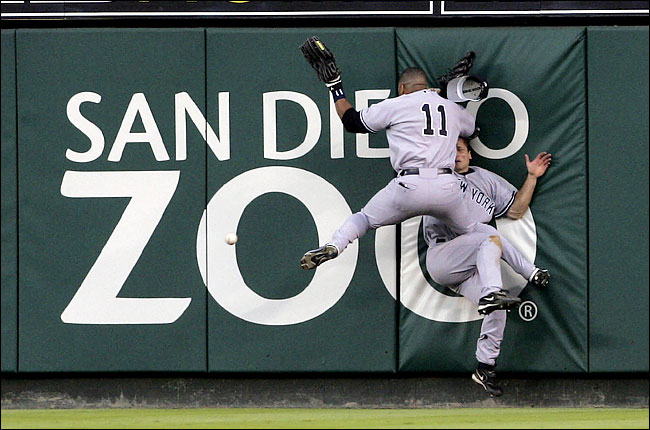A couple of days ago, I wrote a post about the New York Yankees and Robinson Cano. I argued that the Yankees’ concerns about giving Cano a massive long term extension are overblown and that they have the financial resources to do whatever they want. At the end of that post, I promised to write another one disputing everything I had already said and claiming that the Yankees are the Titanic, the once unsinkable ship brought to its knees by an Alex Rodriguez, CC Sabathia, and Mark Texeira shaped iceberg. This is that post.
As I said last time, the Yankees have nearly unlimited financial resources; if not unlimited, they have a far more extensive war chest than any other team in baseball, except maybe the Dodgers. I said that they have the ability to pay anyone they want nearly anything they want and I stand behind that claim. This litany of $200 million deals will not destroy this franchise, no matter what the budget minded Hal Steinbrenner says. There is, however, a more covert aspect of massive long term deals that will ultimately eat away at the very foundation of Yankee lore like so many aging and overpaid termites. (These metaphors doing it for you?)
No one makes money by winning baseball games. People make money selling access to baseball teams: the rights to watch the team in person or on television, and the merchandise to be a “part” of it. But, it just so happens that successful teams are much easier to sell than their unsuccessful brethren. Thus, while players and coaches may work their fingers to the bone to reach that elusive level of greatness, owners care about winning only as far as the residuals: money from the playoff gates and the marketability of success. (Yes, this is an overly cynical view, but it occurs to me that so is most of economics.)
A player is paid $200 million because the JD/MBA running the team determines that the return on that $200 million investment will be worth it–in wins, partly, yes, but really in ticket sales, advertising, and all the other vehicles for revenue generation upon which the team can slap that player’s visage. That visage is so valuable because it is a commodity. The $200 million man, not a $200 million man. (This is why you will never see a full roster of $200 million players: not because teams can’t afford it–because one day they will be able to–but because part of the value of that $200 million dollar man is his mystique.) The Angels have Albert Pujols on their ticket stubs; the Rays drop Evan Longoria from helicopters. Fans respond to the demi-god.
So what is my point with all this? It’s that when you pay someone $200 million to “be a Yankee” for the next decade or more, you are making an on-field commitment to an off-field investment. To be worth the money, the player must be marketable; to be marketable, he must be visible.
Here lies the Yankees’ issue. Alex Rodriguez is no longer worth his salary on the field. However, the Yankees can’t just not play him because they need to recoup as much of their investment as possible. They benched him in the playoffs because the value (marketability-wise) of winning the 2012 World Series outweighed that of playing the 2012 Alex Rodriguez. When he returns, during the 2013 regular season, that won’t be the case. To recover what they can from the investment, the Yankees must keep playing A-Rod in the hopes that he increases his off the field value even though he may not be the best baseball option at third base.
This is not a new problem. There has never ever been a 10 year deal that worked perfectly for the team. A player might be elite at the start but, inevitably, by the end they are mediocre at best and an on-field liability at worst. Teams usually don’t care though, because they feel they get enough out of the player in the first few years to justify a steep decline in profitability over the last couple. The Rockies swallow a couple of years of bad Todd Helton now because they made enough on good Todd Helton for seven years or so.
Really, its not a problem when you only have one guy like that. The Yankees? They have, at the bare minimum, three. They may have many more than that. If he’s healthy, A-Rod has to play third. It makes no sense to have a guy making that much money on the bench. That makes him doubly useless: no added wins and no added profits. The same thing goes for Texeira at first, Sabathia in the rotation, Jeter at shortstop, Rivera in the bullpen, and, maybe, Cano at second. For now, it’s a small but unmistakeable problem. But what about in a few years when everyone is a little bit older and a little bit worse? Big problem.
CC, Tex, Jeet, etc. will still start baseball games even if they are Ronnie Cedeno shaped shadows of their former selves. Why? Because of the money they’ve already made, and that which they are still to make. Thus, and to wrap up rather quickly, it is not the money that will sink the Yankees, it is the commitment the money entails. When you pay a player such a large sum, you have to play the player to make it worth your while. The Yankees are looking at a situation where they will have so many expensive, old, bad players that they will be an expensive, old, bad team. They’ve been fighting this reality off for a while, but with each day that passes and each new commitment the team makes, the inevitable comes one step closer.
-Max Frankel














